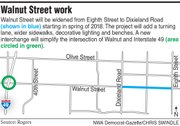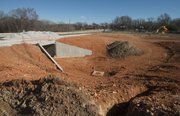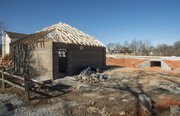ROGERS — Realigning Monte Ne Road is nearing completion, but drivers can expect two more major projects on some of the city’s busiest roads in the coming year.
Walnut Street will be widened from four lanes to five, and the interchange at Walnut and Walton streets and exit 85 on Interstate 49 will get an update, said Lance Jobe, city engineer.
The city’s ever-growing and improving road system contributes to its success, Mayor Greg Hines said. Revenue from a 1 percent sales tax for capital improvements pays for the work, he said. The sales tax was first passed in the early 1980s, likely around the time of the centennial celebration when the city was especially focused on preservation, said Terrilyn Wendling, assistant director of the Rogers Historical Museum.
“It’s been successful for years. It turned us into Northwest Arkansas’ retail destination, an entertainment district and Pinnacle Hills is the downtown of the region,” Hines said.
Infrastructure work, including roads and utilities, attracts businesses because it drives down costs for developers, he said.
A total of $103 million was dedicated to infrastructure changes from a 2011 bond issue, Hines said. About $60 million of that was set aside for street improvement.
MONTE NE WORK
Work on Monte Ne Road began in October 2016 with a goal to transform it into a four-lane boulevard complete with grassy median, 10-foot-wide sidewalks to accommodate cyclists and a couple of roundabouts. The $9.3 million construction project is expected to wrap up in April 2018. It’s ahead of schedule, but weather delays are expected.
“The road construction is close to done, but there’s quite a bit of sidewalk to go,” Jobe said. Construction crews began a second round of paving last week, but a finishing course is still needed. Traffic can now travel down to the roundabout.
The project connects the area to the city by linking it to Old Wire Road. The work also fixes 90-degree bends that impeded traffic flow, he said.
Wrecks were common in the area prior to the improvements where motorists would run off the road at the wild curves. Solving the problematic area helps with city growth, Jobe said, because it will be able to handle more traffic.
The work on Monte Ne includes upgrades to Maple Grove Park, the oldest park in the city. Renovation is to be completed this spring include a restroom, paved parking lot and a tunnel that takes pedestrians who are headed toward the Railyard Bike Park under the road, he said.
Park visitors previously parked on the streets and pedestrians had no connectors between Monte Ne and the Railyard Park, he said.
WALNUT STREET WIDENING
Plans call for Walnut Street to be widened from Eighth Street to Dixieland Road to create a turn lane and wider sidewalks. The update, set to start in the spring, will make for a fresh look using decorative pavement, benches and lighting.
The latest construction estimate is $10.8 million, which doesn’t include the cost of right of way acquisition or utility relocation costs, Jobe said.
The Arkansas Department of Transportation is reviewing the project’s right of way plans. Construction plans are about 90 percent complete, Jobe said, so the city is getting ready to finalize and bid the project.
One utility will take more time to work out than others for this special project. Overhead electrical lines will be placed underground to make the entrance to downtown Rogers more aesthetically pleasing, Jobe said.
Shey Bland, director of Main Street Rogers, said one aim of the work is to slow the traffic so the area is more pedestrian friendly.
“I think the work intended for the Eighth and Walnut intersection will improve the appearance of one of our entry points, corridors to downtown. I believe these various upgrades to our streets … make it safer and more welcoming,” she said.
Bland said she could see the possibility of more visitors and increased frequency of their trips if both driving and cycling routes are improved.
INTERSTATE INTERCHANGE
A new interchange at the intersection of Walnut Street and Interstate 49 will set Rogers apart, making it the first city in Arkansas to have a single-point urban interchange.
Stoplights on either side of the interstate will be eliminated in favor of a single traffic signal beneath the overpass.
“People getting off and on the interstate, as well as those on Walnut/Walton will be controlled by one common signal,” said Steve Lawrence, District 9 engineer for the state Transportation Department. “It will move a lot more traffic more efficiently.” Walnut Street turns into Walton Boulevard once it goes under the interstate into Bentonville.
Single-point urban interchanges are common in other parts of the country. Lawrence said he has seen them in Missouri and South Dakota.
Rogers entered the $23 million project jointly with the state and Bentonville. The work spans the boundary line of the two cities.
Lawrence said Rogers and Bentonville first considered a diverging diamond interchange design, which would have Walnut and Walton traffic cross to opposite sides of the road under the Interstate bridge. The design wouldn’t work because the cities wanted to keep traffic lights at nearby 46th Street and Moberly Lane, he said.
Changing to the single-point urban interchange design meant a $6 million cost increase. Rogers and Bentonville agreed to contribute $1.5 million each, Lawrence said. The remaining $3 million will be covered by the Department of Transportation.
“It creates some additional room … alleviates congestion and helps us plan for the future,” Jobe said.
The project will be contracted in late 2018 or early 2019, and construction is estimated to take 18 months to two years, Lawrence said. The interstate bridges will need to be widened and lengthened, he said.
April Wallace can be reached by email at [email protected] or on Twitter @NWAApril.




